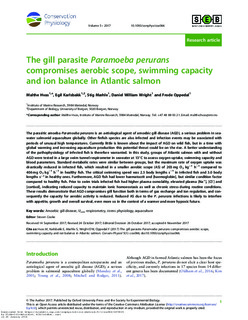| dc.description.abstract | The parasitic amoeba Paramoeba perurans is an aetiological agent of amoebic gill disease (AGD), a serious problem in seawater salmonid aquaculture globally. Other finfish species are also infected and infection events may be associated with periods of unusual high temperatures. Currently little is known about the impact of AGD on wild fish, but in a time with global warming and increasing aquaculture production this potential threat could be on the rise. A better understanding of the pathophysiology of infected fish is therefore warranted. In this study, groups of Atlantic salmon with and without AGD were tested in a large swim tunnel respirometer in seawater at 13°C to assess oxygen uptake, swimming capacity and blood parameters. Standard metabolic rates were similar between groups, but the maximum rate of oxygen uptake was drastically reduced in infected fish, which resulted in a smaller aerobic scope (AS) of 203 mg O2 kg−1 h−1 compared to 406 mg O2 kg−1 h−1 in healthy fish. The critical swimming speed was 2.5 body lengths s−1 in infected fish and 3.0 body lengths s−1 in healthy ones. Furthermore, AGD fish had lower haematocrit and [haemoglobin], but similar condition factor compared to healthy fish. Prior to swim trials infected fish had higher plasma osmolality, elevated plasma [Na+], [Cl-] and [cortisol], indicating reduced capacity to maintain ionic homoeostasis as well as chronic stress during routine conditions. These results demonstrate that AGD compromises gill function both in terms of gas exchange and ion regulation, and consequently the capacity for aerobic activity is reduced. Reduced AS due to the P. perurans infections is likely to interfere with appetite, growth and overall survival, even more so in the context of a warmer and more hypoxic future. | nb_NO |
